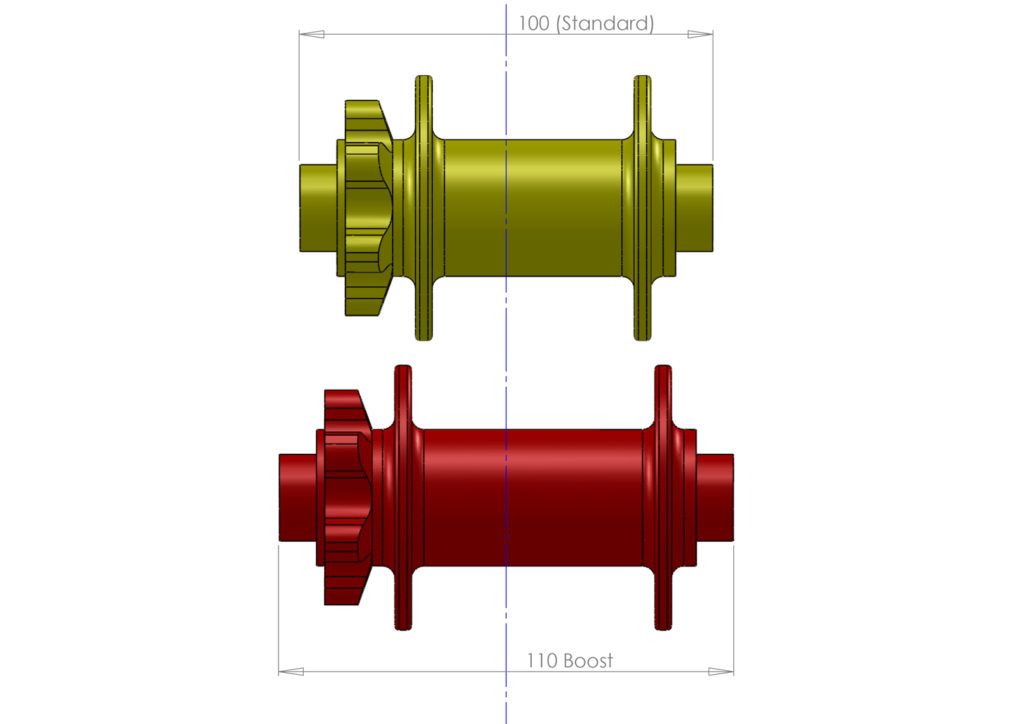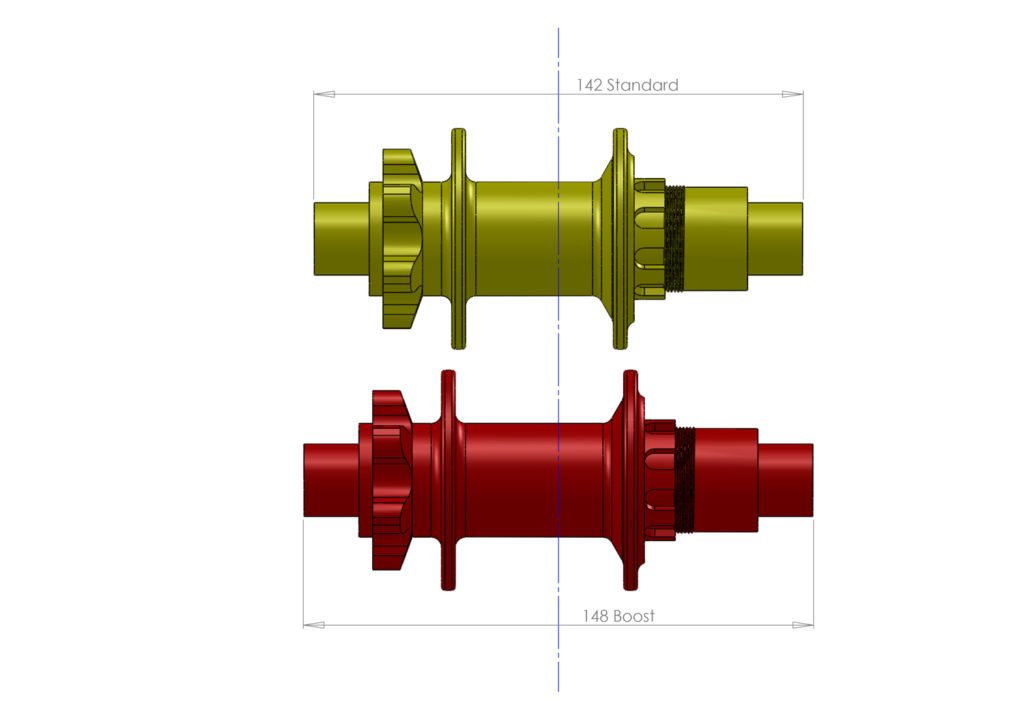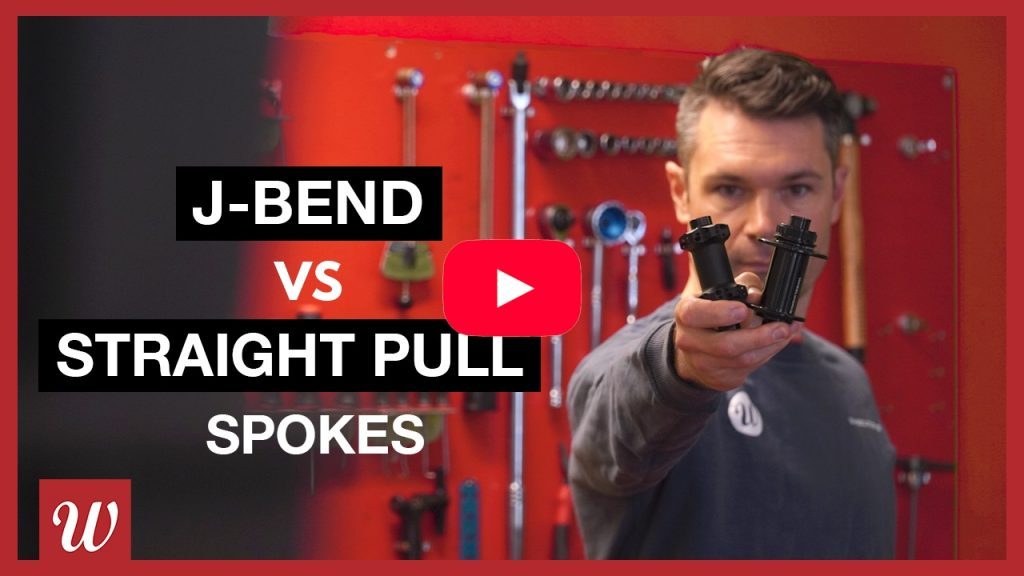Converting your hubs to Boost
Want to convert your current hubs to Boost? There are a few different ways of going about this and the best way is highly dependent on what hub you have. Here I'll cover what I think the best options are for the common hubs that we sell.
The main thing we're trying to avoid is needing to re-dish the wheel. Many Boost kits require you to re-dish the wheel which is something we want to avoid at all costs. We've got to a lot of effort to ensure your spoke lengths are *perfect* and re-dishing will destroy all this hard work as re-dishing will leave you with some spokes too short and some too long with the result being broken spokes and broken nipples.
If you need a refresher on what Boost is then jump to the bottom of this page.
-Tristan
How and why?
The goal of these kits is to space out the axle width while keeping the hub centered so that a re-dish is not required. This means correctly re-spacing both the axle and the disc rotor.
Spacers vs endcaps
Most of these options can be broken down into two groups - those that replace your endcaps with new ones, and those which add spacers.
The kits that add spacers will leave you with small parts which are likely to fall out and get lost when you remove your wheels so be warned.

Note:
Front: All of these suggests assume you start with a 100x15mm front hub and want to convert to 110x15mm
Rear: All of these suggests assume you start with a 142x12mm rear hub and want to convert to 148x12mm
Chris King ISO
Front: Your best option is the MRP kit.
Rear: Our Generic Rear Hub Adapter is the best option.
DT Swiss 240s or 350s Center Lock (excluding EXP version)
Front: You've got two options - the MRP kit which will require a rotor adapter (ie: you might need to go to a larger rotor) or the ZRace kit which will require you to convert to a 6-bolt rotor.
Rear: The ZRace kit is the best option which will require you to convert to a 6-bolt rotor.
DT Swiss 240s or 350s 6-bolt (excluding EXP version)
The MRP kit is a really tidy option with no loose spacers to fall out.
Rear: Our Generic Rear Hub Adapter is the best option.
DT Swiss 180 EXP or 240s EXP Center Lock
Front: The ZRace kit is the best option which will require you to convert to a 6-bolt rotor.
Rear: The ZRace kit is the best option which will require you to convert to a 6-bolt rotor.
DT Swiss 240s EXP 6-bolt
Front: Our Generic Front Hub Adapter is the best option.
Rear: Our Generic Rear Hub Adapter is the best option.
Hope Pro2 / Pro2 EVO / Pro4
Front: For all intents and purposes these are the same front hub. The MRP kits designed for these hubs will work best.
Rear: The Hope kit is the best option.
Wheelworks Dial Center Lock
Front: The ZRace kit is the best option for this hub. You'll need to convert to a 6-bolt rotor.
Rear: The ZRace kit is the best option which will require you to convert to a 6-bolt rotor.
Wheelworks Dial 6-bolt
Front: Our Generic Front Hub Adapter is the best option.
Rear: Our Generic Rear Hub Adapter is the best option.
Other brands 6-bolt
Front: Our Generic Front Hub Adapter is the best option.
Rear: Our Generic Rear Hub Adapter is the best option.
Other brands Center lock
Front: The ZRace kit is the best option for this hub. You'll need to convert to a 6-bolt rotor.
Rear: The ZRace kit is the best option which will require you to convert to a 6-bolt rotor.
What is Boost?
Boost refers to front hubs which are 10mm wider and rear hubs which are 6mm wider than ‘standard.’ Boost front hubs use the same diameter 15mm front and 12mm rear axles.
By making the hubs wider wheels can be built which are stiffer, and more clearance is available for 11 and 12 speed drivetrains. The wider Boost rear hub means that cassette is moved outboard by 3mm and so Boost-specific cranks and chainrings are needed to retain good chainline.

Does Boost Make a Stronger Wheel?
No, not really. All things being equal there will be only a marginal increase in wheel strength and possibly an equally marginal increase in the resistance to taco-ing in a really big crash. We’re talking tiny amounts though.
Does Boost Make a Stiffer Wheel?
Yes. The wider Boost hub flanges allow the spokes to make a wider triangle and better support the rim. This increase in wheel stiffness was the primary driver for the development of Boost. Many new 'factory' wheelsets use straight-pull hubs and these have a decrease in flange width of approximately 3mm so moving to Boost reclaims what was lost by using straight-pull.
This may go against what the Industry tells you but straight-pull hubs will decrease the wheel’s stiffness because of the extra room needed to lay the pulling and pushing spokes side by side. If the Industry had stuck with J-bend spokes there wouldn’t be much need for Boost, but the cost-savings of wheelbuilding with straight-pull hubs have driven their adoption. We made a video explaining this:
The driveside spoke bracing angle on a typical rear wheel is around 4.3* and Boost will increase this by 0.6*. That’s not a whole lot.

Is Boost the Same As 27.5+?
No. Boost refers to the hub with, the + refers to tyre width. It’s worth mentioning that many + bikes use Boost hubs though.
Do I Need To Move To Boost?
No. You could buy Boost forks but you can’t retrofit a Boost rear-end to your bike, and even if you could the advantages aren’t enough to justify the cost.
Buying new and want to future-proof?
Want to buy some wheels for your current non-Boost bike with the option of taking them to a newer Boost bike in the future? The Hope Pro4 is our choice as it's the only hub which has Boost kits which don't require a re-dish and don't have any small parts to fall out.
What Compatibility is There with My Current Wheels and Crankset?
None. A Boost frame requires a Boost hub, and unlike the move from 135mm quick release to 142x12 the actual hub has widened meaning that it’s not possible to run a Boost frame without Boost wheels, or to run Boost wheels in a non-Boost frame.
To run the correct Boost chainline you’ll need either a new chainring or a new crankset, depending on what make and model you’ve currently got.
My Head Hurts
Mine too. Just like cell phones or laptops the cycling industry is constantly looking for negligible improvements on products. Anyone who has compared a 5 year old bike to a modern one will notice the sum of many small improvements.
